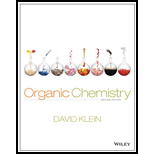
Organic Chemistry
2nd Edition
ISBN: 9781118452288
Author: David R. Klein
Publisher: WILEY
expand_more
expand_more
format_list_bulleted
Question
Chapter 18.7, Problem 5LTS
Interpretation Introduction
Interpretation: For the given compound, major product should be predicted when it is treated with Birch condition.
Concept introduction:
- Birch reduction converts
aromatic compound having benzoid ring in to a product 1, 4-cyclohexa diene. - The product having hydrogen atoms attached on opposite end of the molecule
- Birch reduction is the reduction of aromatic rings with sodium , potassium or lithium and an alcohol in liquid ammonia
- Birch reduction is unlike catalytic hydrogenation
- When benzene with an electron donating group such as alkyl group is treated with Birch reduction, the carbon atom connected to the alkyl group is not reduced. Electron donating effect destabilizes the radical anion.
- When an electron withdrawing groups are used, different regiochemical outcome is observed. Electron withdrawing effect stabilizes the intermediate.
Expert Solution & Answer
Want to see the full answer?
Check out a sample textbook solution
Students have asked these similar questions
please help and i am so confused if the picture is the gc data or ir spectrum. you dont have to do everything just what you can please because i am lost and the mass of the cloves was Mass of cloves 62.299g. Mass of recovered clove oil 62.761g.
Which compound would you expect to have a higher decomposition temperature,Na2CO3 or Cs2CO3? Justify your answer, but you do not need to do any calculations.
Can I get some help drawing my arrows. I included what the final needs to look like
Chapter 18 Solutions
Organic Chemistry
Ch. 18.2 - Prob. 1LTSCh. 18.2 - Prob. 1PTSCh. 18.2 - Prob. 2ATSCh. 18.2 - Prob. 3ATSCh. 18.2 - Prob. 4ATSCh. 18.2 - Prob. 5ATSCh. 18.4 - Prob. 6CCCh. 18.4 - Prob. 8CCCh. 18.4 - Prob. 9CCCh. 18.5 - Prob. 10CC
Ch. 18.5 - Prob. 2LTSCh. 18.5 - Prob. 11PTSCh. 18.5 - Prob. 12ATSCh. 18.5 - Prob. 13ATSCh. 18.5 - Prob. 14ATSCh. 18.5 - Prob. 3LTSCh. 18.5 - Prob. 15PTSCh. 18.5 - Prob. 16ATSCh. 18.5 - Prob. 17ATSCh. 18.5 - Prob. 18CCCh. 18.6 - Prob. 19CCCh. 18.6 - Prob. 4LTSCh. 18.6 - Prob. 20PTSCh. 18.6 - Prob. 21ATSCh. 18.6 - Prob. 22ATSCh. 18.6 - Prob. 23ATSCh. 18.7 - Prob. 5LTSCh. 18.7 - Prob. 24PTSCh. 18.7 - Prob. 25ATSCh. 18.8 - Prob. 26CCCh. 18.8 - Prob. 27CCCh. 18 - Prob. 28PPCh. 18 - Prob. 29PPCh. 18 - Prob. 30PPCh. 18 - Prob. 31PPCh. 18 - Prob. 32PPCh. 18 - Prob. 33PPCh. 18 - Prob. 34PPCh. 18 - Prob. 35PPCh. 18 - Prob. 36PPCh. 18 - Prob. 37PPCh. 18 - Prob. 38PPCh. 18 - Prob. 39PPCh. 18 - Prob. 40PPCh. 18 - Prob. 41PPCh. 18 - Prob. 42PPCh. 18 - Prob. 43PPCh. 18 - Prob. 44PPCh. 18 - Prob. 45PPCh. 18 - Prob. 46PPCh. 18 - Prob. 47PPCh. 18 - Prob. 48PPCh. 18 - Prob. 49PPCh. 18 - Prob. 50PPCh. 18 - Prob. 51PPCh. 18 - Prob. 52PPCh. 18 - Prob. 53IPCh. 18 - Prob. 54IPCh. 18 - Prob. 55IPCh. 18 - Prob. 56IPCh. 18 - Prob. 57IPCh. 18 - Prob. 58IPCh. 18 - Prob. 59IPCh. 18 - Prob. 60IPCh. 18 - Prob. 61IPCh. 18 - Prob. 62IPCh. 18 - Prob. 63IPCh. 18 - Prob. 64IPCh. 18 - Prob. 65IPCh. 18 - Prob. 66IPCh. 18 - Prob. 67IP
Knowledge Booster
Similar questions
- Which of the m/z values corresponds to the base peak in the mass spectrum shown? 100 80 A. 45 B. 44 C. 29 D. 15 Intensity 20 0 10 20 30 40 B- m/z -8 50 E. 30 Which of the m/z values correspond to the molecular ion for the compound shown? A. 18 B. 82 OH C. 100 D. 102 E. 103arrow_forwardCan someone help me with drawing my arrows.arrow_forwardCan I get help drawing my arrows #2arrow_forward
- Can I get some help with my arrows? I have included what the final outcome needs to look like. #3arrow_forwardPlease explain how to calculate the pH.arrow_forwardI'm having trouble with converting lewis diagrams into VSEPR diagrams. I currently have this example of C2BrCl3 which I want to turn into a lewis structure, but I'm not sure what steps I need to do in order to do so. I have the table written down, however, there's two central atoms so what would I do? There seems to be 4 electron domains on the carbon atom and no lone pairs so it would seem like this shape would be tetrahedral. Here's what I have now. Thanks!arrow_forward
arrow_back_ios
SEE MORE QUESTIONS
arrow_forward_ios
Recommended textbooks for you
 ChemistryChemistryISBN:9781305957404Author:Steven S. Zumdahl, Susan A. Zumdahl, Donald J. DeCostePublisher:Cengage Learning
ChemistryChemistryISBN:9781305957404Author:Steven S. Zumdahl, Susan A. Zumdahl, Donald J. DeCostePublisher:Cengage Learning ChemistryChemistryISBN:9781259911156Author:Raymond Chang Dr., Jason Overby ProfessorPublisher:McGraw-Hill Education
ChemistryChemistryISBN:9781259911156Author:Raymond Chang Dr., Jason Overby ProfessorPublisher:McGraw-Hill Education Principles of Instrumental AnalysisChemistryISBN:9781305577213Author:Douglas A. Skoog, F. James Holler, Stanley R. CrouchPublisher:Cengage Learning
Principles of Instrumental AnalysisChemistryISBN:9781305577213Author:Douglas A. Skoog, F. James Holler, Stanley R. CrouchPublisher:Cengage Learning Organic ChemistryChemistryISBN:9780078021558Author:Janice Gorzynski Smith Dr.Publisher:McGraw-Hill Education
Organic ChemistryChemistryISBN:9780078021558Author:Janice Gorzynski Smith Dr.Publisher:McGraw-Hill Education Chemistry: Principles and ReactionsChemistryISBN:9781305079373Author:William L. Masterton, Cecile N. HurleyPublisher:Cengage Learning
Chemistry: Principles and ReactionsChemistryISBN:9781305079373Author:William L. Masterton, Cecile N. HurleyPublisher:Cengage Learning Elementary Principles of Chemical Processes, Bind...ChemistryISBN:9781118431221Author:Richard M. Felder, Ronald W. Rousseau, Lisa G. BullardPublisher:WILEY
Elementary Principles of Chemical Processes, Bind...ChemistryISBN:9781118431221Author:Richard M. Felder, Ronald W. Rousseau, Lisa G. BullardPublisher:WILEY

Chemistry
Chemistry
ISBN:9781305957404
Author:Steven S. Zumdahl, Susan A. Zumdahl, Donald J. DeCoste
Publisher:Cengage Learning

Chemistry
Chemistry
ISBN:9781259911156
Author:Raymond Chang Dr., Jason Overby Professor
Publisher:McGraw-Hill Education

Principles of Instrumental Analysis
Chemistry
ISBN:9781305577213
Author:Douglas A. Skoog, F. James Holler, Stanley R. Crouch
Publisher:Cengage Learning

Organic Chemistry
Chemistry
ISBN:9780078021558
Author:Janice Gorzynski Smith Dr.
Publisher:McGraw-Hill Education

Chemistry: Principles and Reactions
Chemistry
ISBN:9781305079373
Author:William L. Masterton, Cecile N. Hurley
Publisher:Cengage Learning

Elementary Principles of Chemical Processes, Bind...
Chemistry
ISBN:9781118431221
Author:Richard M. Felder, Ronald W. Rousseau, Lisa G. Bullard
Publisher:WILEY